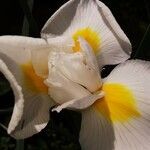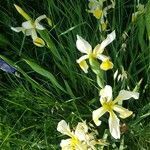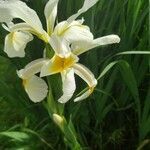Rhizomes sparingly short-branched, forming dense clumps, 1–1.5 cm diam., hard, with old leaf bases at nodes; roots fleshy. Stems slightly flattened, with 1–2 short branches, solid, 4–12 dm. Leaves: basal erect, blade with slight spiral twist and central ridge, 3.5–8 dm × 1–2 cm, stiff, harsh, fibrous, glaucous; cauline 2–3, 1–2 subtending floral clusters, blade reduced. Inflorescence units clustered, 2–4-flowered; spathes white, 3–5 cm, subequal, papery. Flowers: perianth white; floral tube funnelform, 1–2.5 cm; sepals spreading and arching downward, with large yellow basal area, broadly orbicular, 8–10 × 3–6 cm, apex rounded, deeply emarginate; petals white, spatulate, 4–6 × 1–1.5 cm, base gradually attenuate, apex emarginate; ovary triangular in cross section with 2 ribs at each angle, 2–2.5 cm; style white, with parallel sides, 4–5 cm, crests erect, triangular, 1–2 cm; stigmas 2-lobed; pedicel 2.5–7.5 cm. Capsules ovoid to oblong-elliptic, triangular in cross section, each angle 2-ribbed, 4–5 × 2–2.5 cm. Seeds in 2 rows per locule, white, flattened or wedge-shaped, 4–5 mm, papery, wrinkled. 2n = 40.
More
Strong clumps to 1.2 m tall. Rhizome 1-1.5 cm diam. Leaves relatively few, ± glaucous, 2-2.5 cm wide, ± = stems. Stems stout, terete, with 2-3 reduced leaves. Inflorescence unbranched, with 2-3 terminal flowers and 1-2 slightly divergent side-branches, each 1-2-flowered. Flowers long-pedicelled, c. 10 cm diam., white with conspicuous golden marks, faintly scented; tube much < ovary; outer segments with narrow horizontal claw ± 1 cm wide, yellow above, green below, widening abruptly to the deflexed, ovate; white limb, with large central golden patch; inner segments held stiffly at 45 angle, narrow-spathulate, white. Style-branches white, slightly wider than claw of outer segments, oblong-elliptic with acutely bifid crest. Capsule not seen.
Can be grown by divisions or seedlings. Seeds needs stratification.





